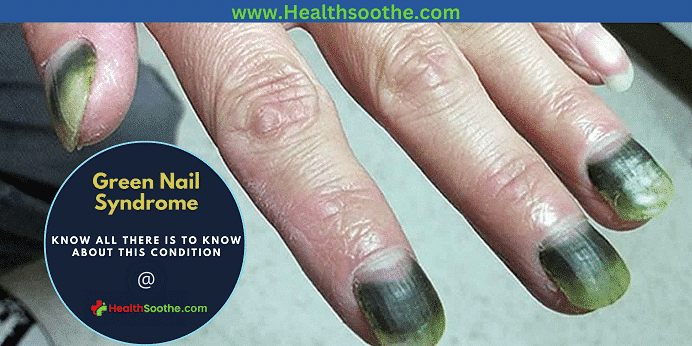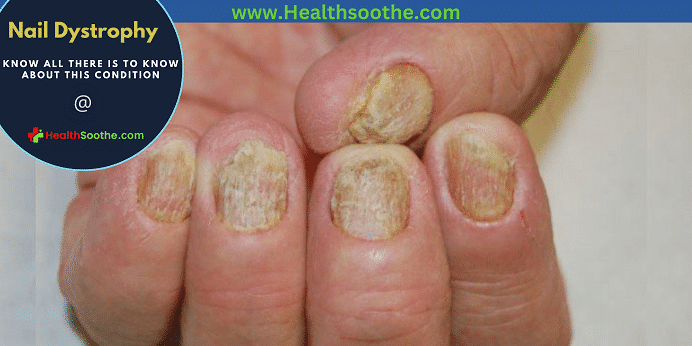Are your nails going green? Or have you seen people with green nails instead of the white color you are used to? Sometimes the color might not be green only. It might vary from blue-green to green-brown, or green-yellow. Usually, only one or two nails are involved. And in some cases, the whole nails change in color,
Quick Facts About Green Nail Syndrome
| A | B |
|---|---|
| Definition | GNS is an infection that leads to a greenish discoloration of nails, known as chloronychia |
| Causes | Infection by Pseudomonas aeruginosa, a common bacterium found in soil, water, and moist environments |
| Symptoms | Green discoloration of the nail, thickening of the nail, pain and tenderness around the nail, separation of the nail from the nail bed |
| Risk Factors | Prolonged exposure to water or moist environments, nail trauma or injury, use of artificial nails, pre-existing nail conditions |
| Diagnosis | Visual examination by a healthcare provider, laboratory culture of nail clippings or swabs to identify Pseudomonas aeruginosa |
| Common In | Gardeners, janitors, plumbers, housewives, dishwashers, cooks, healthcare personnel |
| Treatment Options | Cutting the detached nail portion, keeping nails dry, avoiding trauma, topical antibiotics, diluted chlorine bleach, vinegar, and in severe cases, oral antibiotics |
| Prevention | Keeping nails dry and clean, avoiding prolonged exposure to water, proper nail care and hygiene |
| Prognosis | Generally good with proper treatment; nails typically return to normal color and texture |
| Complications | Rare but can include persistent infection or spread to other areas in severe cases |
Now you are definitely wondering what causes this because that is why you are here, and today, Healthsoothe - your number one trusted health site will answer all your questions concerning this condition.
Now, you must have heard of a condition known as green nail syndrome. If you observe your nails going green or see people whose nails are green, this could be definitely due to this green nail syndrome.
Today, this article aims to explain all there is about this green nail syndrome; What causes it? How is it treated? And what can you do to prevent it? And we will also inform you of other vital or critical things you need to know concerning green nail syndrome.
Alright, enough intro. We move!
Green Nail Syndrome (GNS) – What is it?
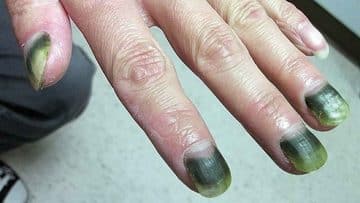
Green nail syndrome (GNS) which is known as chloronychia is a nail disorder characterized by onycholysis and green-black discoloration of the nail bed.1https://en.wikipedia.org › wiki › Green_nail_syndrome This condition is often associated with chronic paronychia. Pseudomonas aeruginosa is the most commonly identified organism in cultures from the affected area.
Green nail syndrome is a paronychial illness caused by Pseudomonas aeruginosa2Greene SL, Su WP, Muller SA. Pseudomonas aeruginosa infections of the skin. Am Fam Physician. 1984;29:193–200. [PubMed] [Google Scholar] that may develop in people who often soak their hands in water. It may also appear as transverse green stripes, which are associated with occasional bouts of illness.
The bacterium "Pseudomonas Aeruginosa," which thrives in damp circumstances, is the most prevalent cause. The frequent immersion of one's fingers in water, detergents, and soils has been related to green nail syndrome. Several activities and accidents have been related to a higher risk of getting the illness.
Wanna watch a video that explains what green nail syndrome is:
What are the Symptoms of Green Nail Syndrome (GNS)?
Green nail syndrome is a nail infection that causes a greenish coloring of the nails, also referred to as chromonychia. The shade of green ranges from blue-green to deep green to bluish-gray.
Because the discoloration lies under the nail, washing or scrubbing will not remove it. The illness generally affects either one or two nails and might affect fingernails or toes. The nail is normally not painful, but the skin surrounding it, especially the cuticle, might become swollen, sensitive, or red.
The most typical sign of green nail syndrome is discoloration of the diseased nail, which becomes a dark green color as a result of bacteria cells or organisms secreting green pigments called pyoverdin and pyocyanin. The patient may also suffer soreness, redness, and swelling around the infected nail.
What Causes Green Nail Syndrome?
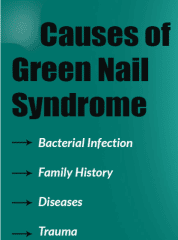
Pseudomonas aeruginosa bacteria causes green nail syndrome. This bacterium thrives in moist conditions like hot tubs, contact lens solutions, drains, and bath sponges. When it grows, it creates the distinctive green pigments pyocyanin and pyoverdin. These same pigments give chloronychia its green hue.
GNS is predisposed to by two key risk factors. The first potential risk is when a nail lifts unnaturally from the nail bed, a condition known as onycholysis. The watertight seal established by the tissue on the nail is removed when the nail is separated from the nail bed. This generates a subungual area that gathers debris and dirt and may enable P. aeruginosa to enter.
Onycholysis is exacerbated by trauma to the region under the nail. Plumbers, gardeners, and janitors are in danger of having their nails split.
A wet atmosphere is the second most significant risk factor. P. aeruginosa seldom colonizes or infects dry skin. Nails that have been repeatedly dipped in water are vulnerable. GNS may be more common among chefs, dishwashers, healthcare workers, and housewives.
It should also be mentioned that using tight-fitting shoes for an extended period of time, particularly when exercising, has been linked to GNS. This has been seen in military recruits as well as soccer players. Fungal nail infections and nail psoriasis infections are minor risk factors for GNS.
Diagnosis and Treatment of Green Nail Syndrome
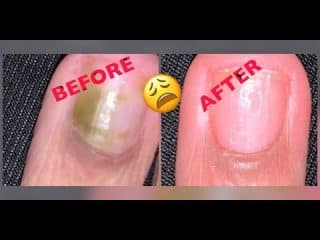
A dermatologist may easily diagnose GNS based on its clinical presentation. In case of dispute, a nail sample might be collected for culture. Treatment for green nail syndrome is effective.
The detached piece of the nail is clipped, the nails are kept dry, and the region is not traumatized. Most patients will be cured if external antibiotics, such as polymyxin B or bacitracin, are used two to four times per day for one to four months.
When administered topically to affected nails, chlorine bleach mixed 1:4 with water is helpful in reducing P. aeruginosa development. Vinegar or acetic acid has also been found to be beneficial in this respect.
If more conservative therapy fails, the nail may have to be removed. An oral antibiotic, like ciprofloxacin, is often recommended during this time. There are several medical treatment options, depending on the severity of the infection and how long it has been present.
The least invasive treatment includes soaking the nail in alcohol and regularly trimming the nail back, to dry out the area and prevent bacterial colonization.
Moderate cases of Green Nail Syndrome are prescribed topical antibiotics (silver sulfadiazine, gentamicin, ciprofloxacin, bacitracin, and polymyxin B) or oral antibiotics (ciprofloxacin), antiseptic creams, tobramycin eye drops have also been reported to be effective.3https://www.aocd.org › page › GreenNailSyndrome
In severe cases, surgical removal of the infected nail may be required. The patient should always avoid further trauma to the infected nail regardless of the stage of treatment they received.
Patient Management and Recovery
In mild to moderate cases, where the infection clears with minimal medical intervention, the patient should ensure the nail is kept clean and dry and avoid hyper-hydration. Humid climates could lead to a longer recovery than dry climes due to the inability to expose the site to very dry air.
In cases where surgery is necessary, patients should follow their medical professional's post-surgery advice.
Prevention of Green Nail Syndrome
Preventative measures should be implemented by those who are most at risk of contracting Green Nail Syndrome due to their predisposition or lifestyle and workplace choices.
Wearing waterproof gloves or gum boots can be effective in preventing prolonged exposure of the nails to water. Avoiding trauma that could lead to the destruction of the epidermis seal on the nails is a priority in preventing green nail syndrome recurrences.
A Word of Advice from Healthsoothe
There have been cases whereby green nail syndrome has been transmitted from an infected person to an uninfected person. Pseudomonas can be transferred among clients in a nail salon if appropriate hygiene standards are not kept up.
While the bacteria wouldn't typically survive on the nail shaping equipment, unclean conditions could allow for it to transfer from the equipment to the client's nails repeatedly. When technicians are presented with a client that has suspected green nail syndrome, they shouldn't continue the normal treatment of painting nails, applying acrylic nails, or otherwise.
This is due to the application of liquids and oils creating an environment where the bacteria can be trapped and treatment will not be possible without the removal of these polishes. As chief science advisor at CND Doug Schoon states “it creates a nearly oxygen-free environment, which these bacteria just love”.
Nail technicians are not qualified to treat green nail syndrome and should educate the client on the condition and encourage them to seek medical treatment before returning to the nail salon.
A man working in a job where he was regularly mixing chemicals developed green nail syndrome. While he mostly wore latex gloves, he reported they would become moist, and often he would remove them to clean his hands and utensils.
The combination of moisture within his gloves and contact with chemicals caused his nails to lift from the nail bed. He developed severe green nail syndrome and was treated with topical antibiotics, which cleared up the infection within 6 months.
It was noted that latex gloves were not suitable for his line of work and more robust rubber gloves should be used. There have been cases where Basel Cell Carcinoma has been present in conjunction with green nail syndrome.
Carcinomas are not common in the area surrounding the nail bed. However, if a Carcinoma is suspected in conjunction with or in place of green nail syndrome, a biopsy should be conducted immediately.
Medical professionals with green nail syndrome have been reported to have transferred the infection to patients in hospitals. Five surgical site infections during 2001 were linked to a cardiac surgeon with the infection who didn't routinely use double gloves. The surgeon's infected nail was surgically removed and no further transfers of the infection were reported.
So all this signifies that one has to be careful and maintain proper hygiene while at home and while working, so as not to fall victim to green nail syndrome.
All right, guys, that is it for now for green nail syndrome. I hope Healthsoothe answered any questions you had concerning green nail syndrome.
Feel free to contact us at contact@healthsoothe.com if you have further questions to ask or if there’s anything you want to contribute or correct to this article. And don’t worry, Healthsoothe doesn’t bite.
You can always check our FAQs section below to know more about green nail syndrome. And always remember that Healthsoothe is one of the best health sites out there that genuinely cares for you. So, anytime, you need trustworthy answers to any of your health-related questions, come straight to us, and we will solve your problem(s) for you.
Frequently Asked Questions About Green Nail Syndrome
Is Green Nail Syndrome Serious?
If your nails exhibit a deep green color, you could have green nail syndrome (GNS), also known by its medical name chloronychia. Green nails are a sign of a serious problem that you can't eliminate with scrubbing. You will likely need medical intervention.
Why is my Nail turning Green under my Acrylic?
Germs, yeast, or fungus can get into the gap and grow. A bacterial infection can turn your nails green.
How do I get rid of Pseudomonas on my Nails?
Vinegar soaks or vinegar drops can be used to eradicate Pseudomonas. Clorox bleach soaks can be used to bleach away the green color. Ciprofloxacin otic drops can also be ordered and patients should apply them under the nail. A course of oral antibiotics is an additional option.
How did I get Green Nail Syndrome?
Green nail syndrome is caused by bacteria called Pseudomonas aeruginosa. This bacterium flourishes in wet environments, such as jacuzzis, contact lens solutions, sinks, and bath sponges. When it grows, it produces hallmark green pigments called pyocyanin and pyoverdin.
Can I put Nail Polish over Pseudomonas?
It is a bacterial infection of pseudomonas. It has been believed for a long time that exposing pseudomonas to the air (oxygen) will destroy it so it is safe to reapply a new coating. In recent years research has discovered that this type of bacteria can survive with or without oxygen so this is not the case.
How do you get Rid of Green Nails Fast?
How to get rid of a fingernail fungus from acrylic nails; Use the following:
- Vinegar.
- Vicks VapoRub
- Tea tree oil
- Oregano oil
- Listerine mouthwash
How Long Does a Green Nail Last?
Tell your client to soak the nail in clear vinegar (not balsamic!) several times daily for a couple of weeks. She should understand that it may take several months for the stain to grow out. If, after three weeks, the issue is not growing out or the green discoloration is spreading, urge your client to visit a doctor.
Is Green Nail Contagious?
Pseudomonas can be transferred among clients in a nail salon if appropriate hygiene standards are not kept up.
What Happens if Green Nail Syndrome is left Untreated?
The infection may produce chronic paronychia if left untreated. It has been found that onycholysis preceded the development of paronychia in most cases. Hot humid climates may require longer treatment than cold dry climates. It is highly unusual to have more than two nails involved.
What kills Pseudomonas Naturally?
I've also consumed manuka honey; this I've done more religiously, as it tastes more like candy than any “medication.” Manuka honey contains the natural antibiotic methylglyoxal, a compound that fights relentlessly against Pseudomonas.
Will Pseudomonas Go Away on its Own?
Most minor Pseudomonas infections resolve either without treatment or after minimal treatment. If symptoms are mild or non-existent, it is not necessary to treat the infection. In the case of a swimmer's ear, rinsing the ear with vinegar can help. A doctor may also prescribe an antibiotic called polymyxin.
How long does it take for Pseudomonas in Nails to go Away?
Green coloration of the toenail. The bacteriologic culture of nail scrapings was positive for Pseudomonas aeruginosa. Fungal coinfection was excluded by potassium hydroxide preparation and culture. The nail plate was cured after 6 weeks of oral ciprofloxacin.
How Quickly does Pseudomonas Spread?
Disease progression varies but can rapidly progress and involve the entire cornea within 48 hours, leading to perforation. Fever and systemic symptoms are usually absent.
Additional resources and citations
- 1https://en.wikipedia.org › wiki › Green_nail_syndrome
- 2Greene SL, Su WP, Muller SA. Pseudomonas aeruginosa infections of the skin. Am Fam Physician. 1984;29:193–200. [PubMed] [Google Scholar]
- 3https://www.aocd.org › page › GreenNailSyndrome

